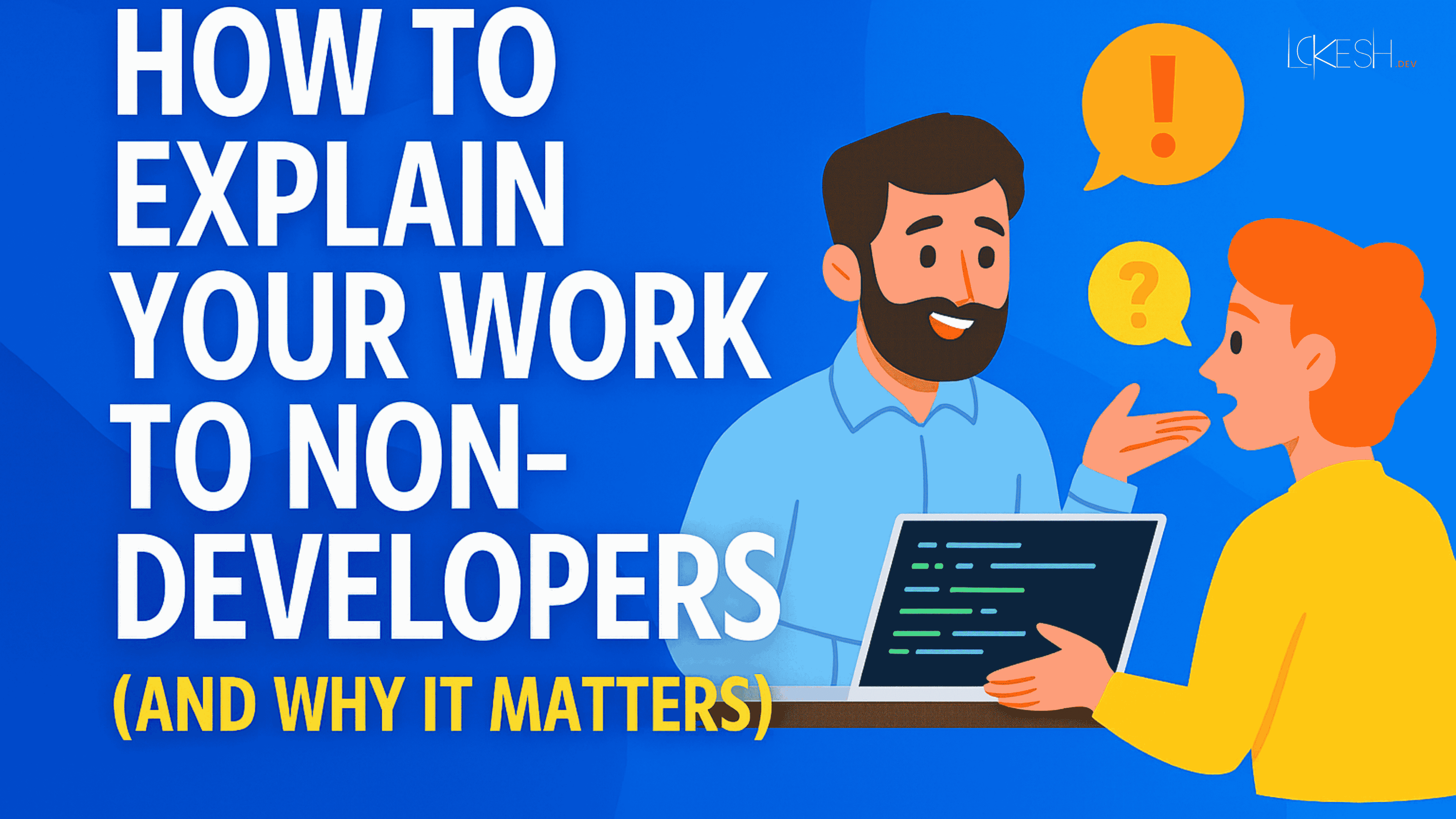October, 08 2025
How to Explain Your Work to Non-Developers (and Why It Matters)

By ~ Lokesh Raikwar
Introduction: Why Communication Matters as Much as Code
In the tech world, we often assume that code speaks for itself. But for developers, especially full-stack engineers who touch multiple parts of a system, communication is just as important as technical skills. Most projects don’t exist in isolation — they involve clients, managers, designers, marketers, or investors who don’t speak the language of APIs, databases, or frameworks. Explaining your work clearly to non-developers ensures smoother collaboration, better decision-making, and stronger trust. In fact, poor communication is one of the biggest reasons projects fail, even when the technical execution is sound. Whether it’s justifying why a feature will take two weeks instead of two days, explaining why SQL is better than NoSQL for a project, or describing how a design decision affects performance, the ability to translate technical complexity into everyday language is a critical skill for developers in 2025. This article explores practical strategies to bridge the communication gap and shows why these skills are essential for career growth.
The Challenge: Why Developers and Non-Developers Struggle to Connect
The root of the communication gap lies in different mental models. Developers think in terms of algorithms, architectures, and systems, while non-developers think in terms of business outcomes, costs, and user experience. For example, a product manager may ask, 'Can we launch this feature next week?' while a developer knows that testing, integration, and database migrations will take far longer. This mismatch often leads to frustration on both sides. Developers feel misunderstood, while stakeholders feel like developers are overcomplicating simple tasks. Another challenge is jargon. Terms like 'refactoring,' 'API endpoints,' or 'technical debt' don’t mean much to non-technical people. Without translation, these words sound alien and create unnecessary barriers. Developers must recognize that communication is not about dumbing down but about aligning perspectives. Explaining technical trade-offs in terms of time, money, and user impact helps non-developers understand the real challenges. Once this gap is acknowledged, developers can focus on bridging it instead of being frustrated by it.
Practical Tips to Explain Technical Work Simply
The key to explaining your work is shifting from technical detail to practical impact. Start with the 'why' before the 'how.' For example, instead of saying, 'We need to normalize the database,' you could explain, 'We’re organizing data more efficiently so searches will be faster for users.' Use analogies that resonate with everyday experiences — like comparing APIs to restaurant menus or technical debt to household repairs. Keep explanations structured: define the problem, explain the solution in plain language, then describe the impact. Visuals also help: diagrams, charts, or simple mockups can often communicate what words cannot. Avoid overwhelming people with unnecessary details; focus on what matters to them — timelines, costs, and outcomes. When talking about risks, frame them as trade-offs: 'We can release this faster, but it may mean more bugs later.' This builds trust and shows that you’re considering the bigger picture. Over time, these communication habits become second nature and make collaboration smoother.
Why Explaining Your Work Builds Trust and Influence
When developers take the time to explain their work clearly, it builds trust with non-technical stakeholders. Clients, managers, and team members appreciate transparency, especially when it comes to timelines, risks, and expected outcomes. This trust translates into smoother projects because stakeholders are more likely to support decisions they understand. It also strengthens your influence as a developer. Instead of being seen as someone who just executes tasks, you become a partner in shaping solutions. For career growth, this is crucial: developers who can bridge the technical-business gap often move into leadership, architecture, or product strategy roles. Even in freelancing, explaining your work well improves client relationships and leads to repeat business. Beyond career benefits, clear explanations also reduce conflict. When non-developers know why a feature takes longer or why a certain approach is necessary, they’re less likely to push back unrealistically. In short, communication isn’t just about clarity — it’s about credibility.
Conclusion: Code Is Powerful, But Clarity Is Priceless
Developers often focus on frameworks, databases, and algorithms, but communication skills are equally vital for success in tech. Being able to explain your work to non-developers bridges the gap between technical execution and business value. It ensures stakeholders make informed decisions, reduces misunderstandings, and builds trust. Most importantly, it positions you as more than just a coder — it makes you a problem solver who can see both the technical and human sides of a project. In 2025, when collaboration across disciplines is more important than ever, the ability to explain your work clearly will set you apart from other developers. So the next time you finish a sprint, push code, or propose a new approach, remember: your job isn’t done until you can explain it in a way that anyone — developer or not — can understand. Code may build products, but clarity builds teams and careers.
Get in touch
We answer quickly. Subscribe for updates or reach out directly.
Let's stay in touch
Based in
![]() Delhi, India
Delhi, India
